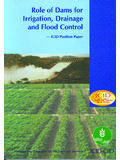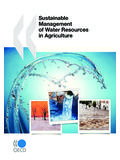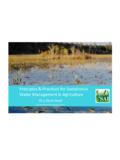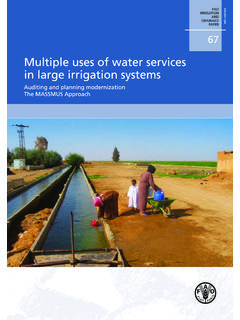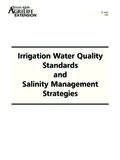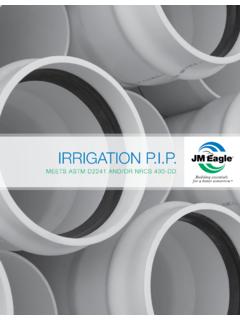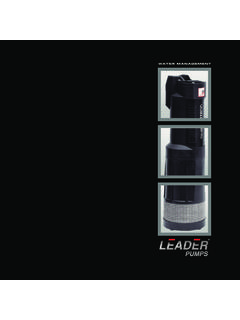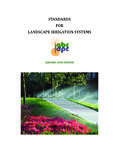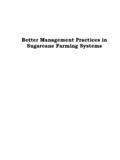Transcription of FAO IRRIGATION AND DRAINAGE PAPER 24
1 FAO IRRIGATION AND DRAINAGE PAPER 24. revi sed 1977. at uirements FOOD AND AGRICULTURE ORGANIZATION. OF THE UNITED NATIONS ROME. FAO IRRIGATION AND DRAINAGE PAPER (2L., revised 1977. clu Mims for [preck'dng i:e[r [aqukramernm by j. d renbos water management specialist land and water development division fao and W. O. PrErfg" fao coreamN:anr1. isTigadzqi isrdivevzKy oaNcinTje, davis, california, , in consultation a. thcautthEieE: gsbar-dc<, ciarivagnez dastane 7,D(AF: . c. van den be.,v2. Lii:artna ashINDscl ( ,-11. m. Va-16. and fao field s FOOD AND AGRICULTURE ORGANIZATION OF THE UNITED NATIONS. Rome 1977. SUMMARY. This publication is intended to provide guidance in determining crop water requirements and their application in planning, design and operation of IRRIGATION projects. Part presents suggested methods to derive crop water requirements. The use of four well-known methods for determining such requirements is defined to obtain reference crop evapotranspiration (ETo), which denotes the level of evapo- transpiration for different climatic conditions.)))]]]
2 These methods are the Criddle, the Radiation, the Penman and Pan Evaporation methods, each requiring a different set of climatic data. To derive the evapotranspiration for a specific crop, relationships between crop (ETcrop) and reference crop evapotranspiration (ETo) are given in Part I . 2 for different crops , stages of growth, length of growing season and prevailing climatic conditions. The effect of local conditions on crop water requirements is given in Part ; this includes local variation in climate, advection, soil water availability and agronomic and IRRIGATION methods and practices . Calculation procedures are presented together with examples. A detailed discussion on selection and calibration of the preSented methodologies together with the data sources is given in Appendix II. A computer programme on applying the different methods is given in Appendix III. Part 11 discusses the application of crop water requirements data in irriga- tionproject planning, design and Part II.
3 1 deals deriving the field water balance, which in turn forms the basis for predicting and peak IRRIGATION supplies for general planning purposes. Attention is given to IRRIGATION efficiency and water requirements for cultural practices and leaching of salts. In Part methods are presented to arrive at field and scheme supply schedules with emphasis towards the field water balance and field IRRIGATION management . Criteria are given for operating the canal system using different methods of water delivery, and for subsequent design parameters of the system. Suggestions are made in Part on refinement of field and project supply schedules once the project is in operation. The presented guidelines are based on measured data and experience obtained covering a wide range of conditions. Local practical, technical, social econo- mic considerations will, however, affect the planning criteria selected. Therefore caution and a critical attitude should still be taken when the presented methodology.
4 TABLE OF CONTENTS. Summary Table of Contents List of Tables List of Figures Conversion Factors Climatological Nometiclature PART I - CALCULATION OF CROP water REQUIREMENTS. CALCULATION OF REFERENCE CROP EVAPOTRANSPIRATION 3. Blaney-Criddle Method 3. Radiation Method 8. Penman Method 15. Pan Evaporation Method 30. SELECTION OF CROP COEFFICIENT 35. FACTORS AFFECTING CROP EVAPOTRANSPIRATION 55. Climate: variation with time, distance, size of IRRIGATION development, advection, altitude 55. Soil water : level of . soil water , groundwater, salinity, water and crop yields 59. Method of IRRIGATION : surface, sprinkler, drip or trickle, sub- surface IRRIGATION 62. Cultural Practices: fertilizers, plant population, tillage, mulching, windbreaks, anti-transpirants 65. PART II - APPLICATION OF CROP water REQUIREMENT DATA IN IDENTI- FICATION , DESIGN AND OPERATION OF IRRIGATION PROIECTS 67. PROJECT IDENTIFICATION AND PRELIMINARY PLANNING 68. Introduction 68.
5 Seasonal and Peak Project Supply Requirements 69. Crop water requirements 71. Net IRRIGATION requirements: effective rainfall, groundwater contribution, stored .soil water 72. IRRIGATION requirements: leaching requirements, IRRIGATION efficiency 76. Summary of calculation of seasonal and peak project supply requirements 81. PROJECT DESIGN 83. introduction 83. Field and Project Supply Schedules 83. Field IRRIGATION schedules: depth of IRRIGATION application, IRRIGATION application interval, calculation of field IRRIGATION schedules 86. Field IRRIGATION supply schedules: surface, sprinkler drip 90. Design and operation of supply system: continuous, rotational, supply on demand 96. Summary calculation of project design and operation 100. PROJECT OPERATION 102. Refinement of Field Supply Schedules: adaptive research, data collection, project monitoring 102. Application of Field IRRIGATION Data 104. Appendix I Persons and Institutes Consulted 107.
6 Appendix II Background and Development of Methods to Predict Reference Crop Evapotranspiration 108. Appendix III Computer Programme for Estimation of Reference Crop Evapotranspiration 120. Appendix IV Glossary 133. Appendix V References 137. Appendix VI Constants for the Radiation Equation Rs = (a + b njol)Ra 144. LIST OF TABLES. Page I. Mean daily percentage (p) of annual daytime hours for different latitudes 6. Extra terrestrial radiation (Ra) expressed in equivalent evaporation in mm/day 12. Mean daily duration of maximum possible sunshine hours (N) for different months and latitudes 13. Values of weighting factor (W) for the effect of radiation on ETo at different temperatures and altitudes 13. Saturation vapour pressure (ea) in mbar as function of mean air temperature (T) in oC 21. Vapour pressure (ed) in mbar from dry and wet bulb temperature data in C. (aspirated psychrometer) 21. Vapour pressure (ed) in mbar from dry and wet bulb temperature data in C.
7 (non-ventilated psychrometer) 22. U2. Values of wind function f(u) = (1 + Tdd) for wind run at 2 m height in km/day 23. Values of weighting factor (1-W) for the effect of wind humidity on ETo at different temperatures and altitudes 24. Values of factor (W) for the effect of radiation on ETo at different temperatures and altitudes 24. Extra terrestrial radiation (Ra) expressed in equivalent evaporation in mm/day 25. Mean daily duration of maximum possible sunshine hours (N) for different months and latitudes 26. Conversion factor for extra-terrestrial radiation (Ra) to net solar radiation (Rns) for a given reflection oc of and different ratios of actual to maximum sunshine hours (1- + n/N) 27. Effect of temperature f(T) on longwave radiation (Rnl) 27. Effect of vapour pressure f(ed) on longwave radiation (Rn1) 27. Effect of the ratio actual and maximum bright sunshine hours f(n/N) on longwave radiation (Rnl) 27. Adjustment factor (c) in presented Penman equation 28.
8 Ratios between evaporation from sunken pans mentioned and from Colorado sunken pan for different climatic conditions and pan environments 33. Pan coefficient (Kp) for Class A pan for different groundcover and levels of mean relative humidity and 24 hour vrind 34. Pan coefficient (Kp) for Colorado sunken pan for different groundcover and levels of mean relative humidity and a hour wind 34. Approximate range of seasonal ETcrop in mm 36. Crop coefficient (kc) for field and vegetable crops for different stages of crop growth and prevailing Climatic conditions 40. Length of growing season and crop development stages of selected field crops; some indications 42. kc values for alfalfa, clover, grass-legtimes and pasture 45. Page kc values for bananas 46. kc values for citrus (grown in predominantly dry areas with light to moderate wind) 47. kc values for full grown deciduous fruit and nut trees 49. kc values for grapes (clean cultivated, infrequent IRRIGATION , soil surface dry most of the time) 50.
9 Kc'values for rice 51. kc values for sugarcane 52. kc values for aquatic weeds and coefficients for open water 54. Tolerance levels of crops to high groundwater tables waterlogging 60. Critical periods for soil water stress for different crops 63. Project planning stages and IRRIGATION supply data 67. Average monthly effective rainfall as related to average monthly ETcrop and mean monthly rainfall 75. Effect of IRRIGATION water quality on soil salinity, permeability and toxicity 77. Crop salt tolerance levels for different crops 78. Conveyance (Ec), field canal (Eb), distribution (Ed) and field application efficiency (Ea) 80. Relation between soil water tension in bars (atmospheres) and available soil - water in mm/m soil depth 86. Generalized data on rooting depth of full grown crops, fraction of available soil water (p) and readily available soil water ( ) for different soil types (in mm/m soil depth) when ETcrop is 5 - 6 mm/day 88. Average intake rates of water in mm/hr for different soils and.
10 Corresponding stream size 1/sec/ha 91. Size of basins and stream size for different soils 93. Length of furrows and stream size for different soil type, land slope and depth of water application 93. Size of borders and stream size for different soil t3rpe and land slope (deep rooted crops) 93. 44 . Operating figures for some sprinklers (square pattern) 94. Flow rate per drip emitter (qe) in l/hr, continuous flow, for different ETcrops and number of emitters per ha 95. Flow rate per tree, continuous flow, for different ETcrop and tree spacing 1/hr 95. Surface area wetted (w) in m2 for different emitter flow and soil infiltration rate LIST OF FIGURES. Page Prediction of ETo from Blaney-Criddle f factor for different conditions of minimum relative humidity, sunshine duration and day time wind 7. Prediction of ETo from for different conditions of mean relative humidity and day time wind 14. Illustration of the radiation balance 18. ETcrop as compared to ETo 35.










